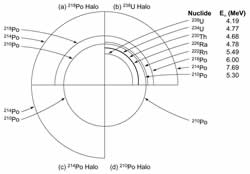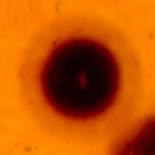Two years ago it was reported that polonium (Po) radiohalos were still "a very tiny mystery."1 Since then, extensive research into the geological occurrence and distribution of Po, uranium (U) and thorium (Th) radiohalos has been undertaken as part of the RATE project,2 so now there are some preliminary results to report that are both significant and exciting.
What Are Radiohalos?
Radiohalos are minute spherical zones of discoloration surrounding tiny mineral crystals included in larger host mineral grains in certain rocks, particularly granites. Alpha-particles produced by radioactive decay of U, Th, and their decay products (including Po) in the tiny mineral inclusions (often zircons) penetrate the surrounding host minerals (often the dark mica, biotite) damaging their crystal lattices. Because the a-particles emitted by the different radionuclides in the U and Th decay chains have different energies, they travel different distances. Where the a-particles stop they do the most damage, resulting in spherical shells of intense discoloration, which are concentric ring structures when the rocks are studied in thin (cross) sections. Therefore, it is possible to identify which radionuclides were responsible for producing the observed radiohalos.
 There are three Po radionuclides in the 238U decay chain…218Po, 214Po and 210Po. All decay very rapidly and so have very short half-lives…3.1 minutes, 164 micro-seconds and 138 days respectively. Thus the occurrence in granitic rocks of 218Po, 214Po, and 210Po radiohalos, exhibiting only the rings produced by these Po radionuclides because only these respective radionuclides were present in the radiocenters when the radiohalos formed (figure 1), has been interpreted as indicating instantaneous formation of both the Po radiohalos and the granitic rocks.3
There are three Po radionuclides in the 238U decay chain…218Po, 214Po and 210Po. All decay very rapidly and so have very short half-lives…3.1 minutes, 164 micro-seconds and 138 days respectively. Thus the occurrence in granitic rocks of 218Po, 214Po, and 210Po radiohalos, exhibiting only the rings produced by these Po radionuclides because only these respective radionuclides were present in the radiocenters when the radiohalos formed (figure 1), has been interpreted as indicating instantaneous formation of both the Po radiohalos and the granitic rocks.3
U and Th radiohalos are not without significance either. Dark, fully-formed U and Th radiohalos are estimated to have required around 100 million years worth of radioactive decay at today's rates to have formed,4 so their presence in granitic rocks throughout the geologic record globally would seemingly imply that at least 100 million years worth of radioactive decay at today's rates has occurred during Earth history.5
 The RATE Research
The RATE Research
The initial focus of the research has been granitic rocks that had to have formed during the Flood year. In each case there is unequivocal evidence that the granitic rocks formed by the melting during metamorphism (changes in rocks induced by heat and pressure) of fossiliferous Flood-deposited sedimentary layers, and that the resultant granitic magmas (melted rocks) then intruded into other Flood-deposited layers. Such Flood-related granitic rocks investigated thus far include the Stone Mountain granite near Atlanta (Georgia), the La Posta zoned granodiorite and related granites in the Peninsular Ranges of southern California east of San Diego, and the Cooma granodiorite and four other granitic bodies in southeastern Australia.
The biotite grains in all these granitic rocks have large numbers of 210Po radio-halos within them, often 4-10 times the numbers of 214Po radiohalos. Dark, fully- formed 238U radiohalos (figure 2) usually occur as equally often as the 214Po radio-halos. 218Po radiohalos are very rare. However, in the Cooma granodiorite and the four other granites of southeastern Australia there are more 238U radiohalos than any of the Po radiohalos, while in two of these granites there are as many 214Po radio-halos as 210Po radiohalos. Dark, fully-formed Th radiohalos are also common in the Cooma granodiorite.
U Radiohalos and Accelerated Decay
What then is the significance of these radiohalos, discovered in this first ever systematic search in these granitic rocks? The presence in them of so many dark, fully-formed U and Th radiohalos clearly implies that at least 100 million years worth of radioactive decay at today's rates must have occurred in these granitic rocks since they formed. However, these granitic rocks evidently formed only recently during the Flood year, so this implies that at least 100 million years worth of radioactive decay at today's rates must have occurred during the Flood year, when geologic processes were operating at catastrophic rates. Thus the rates of radioactive decay had to have been accelerated during the Flood year and therefore conventional radioisotopic dating of rocks, which assumes constant decay rates, is unreliable and conventional "ages" are grossly in error.
Furthermore, such accelerated radioactive decay would have generated a large pulse of heat during the Flood. This in turn would have helped to initiate and drive the global tectonic processes that operated during the Flood year, and to accomplish catastrophically much geologic work, including the regional metamorphism of sedimentary strata and the melting of crustal and mantle rocks to produce granitic and other magmas.
Po Radiohalo Formation and Rapid Geologic Processes
However, the Po radiohalos are also still highly significant, due to their exceedingly short half-lives. Because these granitic rocks containing them are neither created nor primordial, the Po that parented these Po radiohalos cannot have been primordial.6 Whatever secondary processes were thus responsible for separating the necessary Po from its parent U and concentrating it into the radiocenters, the timescale involved had to be very short.
Limited space here precludes a full technical explanation and detailed justification of a proposed mechanism for Po radiohalo formation, but a comprehensive paper is being prepared for presentation at next summer's International Conference on Creationism.7 In summary, many related lines of evidence suggest a viable hydrothermal (hot water) fluid transport model in which the immediate precursors to the Po isotopes, probably accompanied by the Po isotopes themselves, were carried exceedingly short distances within the biotite flakes from U decay in adjacent enclosed zircon grains. The Po isotopes were then continuously concentrated in appropriate radiocenters by attractive ions in lattice defects within the biotite flakes, and the Po radiohalos then formed.
The implications are far-reaching. Because the half-lives of these Po isotopes are very short, the hydrothermal fluid transport had to be extremely rapid. The hydrothermal fluids are generated as the granitic magmas cool, so the timeframe for the cooling of these granitic magmas has to have been extremely short (only days!) as the expelled hydrothermal fluids also carried away the heat.8 Because hydrothermal fluids also transport other metals in solution (such as gold, tin, copper, lead, zinc), these rapid flows of hydrothermal fluids had the potential to also rapidly deposit metallic ores, again within days! And finally, preliminary reports of U, Th, and Po radiohalos in regionally metamorphosed rocks9 could confirm that large-scale rapid flows of hydrothermal fluids catastrophically formed regional metamorphic complexes.10
Perhaps the Po radiohalos are no longer "a very tiny mystery." If so, the U, Th, and Po radiohalos are potentially powerful evidence of the catastrophic geologic processes within the Flood year on a young Earth. Investigations are continuing on Flood-related granites; other investigations are now going to include pre-Flood granitic rocks that might extend this evidence even back into the Creation Week.
Endnotes and References
- Snelling, A.A., "Polonium Radiohalos: Still 'A Very Tiny Mystery'," (Institute for Creation Research, El Cajon, CA., Impact #326, 2000), pp. i-iv.
- RATE stands for "Radioisotopes and the Age of The Earth," a research initiative of the Institute for Creation Research and the Creation Research Society. Details about the RATE project can be found at www.icr.org and in the book in reference 5.
- Gentry, R.A., Creation's Tiny Mystery (Knoxville, TN: Earth Science Associates, 1988).
- Gentry, R.A., "Radioactive Halos," Annual Review of Nuclear Science 23 (1973), pp. 347-362. Gentry, R.V., "Radiohalos in a Radiochronological and Cosmological Perspective," Science 184 (1974), pp. 62-66.
- For a comprehensive review of the details of all known radiohalo types and the controversy over them, see: Snelling, A.A., "Radiohalos," in Radioisotopes and the Age of The Earth: A Young-Earth Creationist Research Initiative, edited by L. Vardiman, A.A. Snelling, and E.F. Chaffin (Institute for Creation Research, El Cajon, CA., and Creation Research Society, St. Joseph, MO., 2000), pp. 381-468.
- Created rocks would be the rocks created by fiat in the sequence of God-directed steps recorded in Genesis 1. Such fiat creation could have involved processes akin to those we observe today, but accomplished at incredible speeds. Primordial rocks and elements are those that would have existed from the beginning of the earth at its formation, early in the sequence of God-directed steps.
- Snelling, A.A. and M.H. Armitage, "Radiohalos…A Tale of Three Granitic Plutons," in Proceedings of the Fifth International Conference on Creationism, in preparation.
- Snelling, A.A., and J. Woodmorappe, "The Cooling of Thick Igneous Bodies on a Young Earth," in Proceedings of the Fourth International Conference on Creationism, edited by R.E. Walsh (Pittsburgh, PA: Creation Science Fellowship, 1998), pp. 527-545.
- Rimsaite, J.H.Y., "Studies of the Rock-Forming Micas," Geological Survey of Canada Bulletin 149 (1967). Nasdala, L., M. Wenzel, M. Andrut, R. Wirth, and P. Blaum, "The Nature of Radiohalos in Biotite: Experimental Studies and Modeling," American Mineralogist 86 (2001), pp. 498-512. Wise, K.P., "Radioactive Halos: Geological Concerns," Creation Research Society Quarterly 25 (1989), pp. 171-176.
- Snelling, A.A., "Towards a Creationist Explanation of Regional Metamorphism," Creation Ex Nihilo Technical Journal 8 (1994), pp. 51-77.
* At time of publication, Dr. Snelling was Professor of Geology for the ICR Graduate School.
Cite this article: Snelling, A. A. 2002. Radiohalos…Significant And Exciting Research Results. Acts & Facts. 31 (11).













